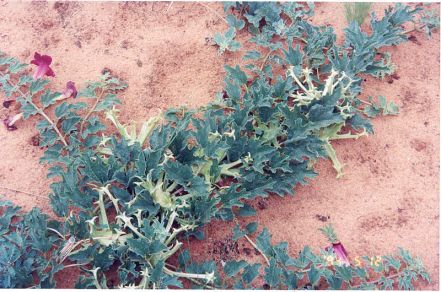Lots of things happening, and I have had a severe downturn with spasms in my face making things very difficult when it comes to eating and, well, functioning overall since it feels like my head is trapped in this perpetual vice. But I am still getting around and cramming as much life into my better than bad days as I can!
Like Fishfuddle, this has a scary sounding name, but unlike it Devil’s Claw is much less hazardous while just as helpful. Devil’s Claw, or for you people that like Latin names, Harpagophytum procumbens, which is found through much of Africa and has been known there for ages and used to treat a wide range of illnesses, fever, malaria, stomach issues, constipation, but mostly used to treat various inflammatory pain issues. It was well known for treating diseases like rheumatoid arthritis, and it is its anti-inflammatory abilities that make this a great herb to use to treat a lot of pain issues.

Devil’s claw, it would almost look harmless if you didn’t know those light parts will dry hard and spiky.
The parts of the plants used are the large roots, but this herb gets its name from it’s seed case. Which looks like a wicked painful thing to step on.
It is also known by other names like grapple plant and wood spider. Which I think accurately describe this vicious looking spiked pod. It is a craftily designed shape though, which David Attenborough explains in his informative dulcet tones.
Africa was lucky enough to have this plant readily available and it was used in Africa for centuries. Then, later on in history, there was an uprising against the German colonialism and it is a pretty horrible story to read, but it allowed the interaction (according to myth) between a local healer and a soldier/farmer, a guy named G. H. Mehnert. It seems that this is a constructed legend that has possibly been debunked. What we do know for sure is that it did make its way to Germany, and then had a boom in interest during the 1970’s in Europe. It was quickly noted that it treated inflammatory diseases, and it grew in popularity, sometimes to where demand could not be met with supply in some areas.
It has started to gain more interest as it is studied more, and has had promising results in treating back pain as well as rheumatoid arthritis and other arthritis like disorders. Of course there isn’t enough evidence to say 100% this is the best thing to do but it looks like this could be a new promising direction for new anti-inflammatories and treatment for back pain and even possibly migraines. The active chemicals that seems to be the source of the plants ability are harpagoside (an iridoid glycoside – which chemicals common in medicinal plants), procumbide (also iridoid glycoside) and plant sterols (which are basically plant steroids – think similar to cortisone). These have all been studied and results are, again not 100%, but looks good. The current theories are that like some NSAIDS the chemicals in Devil’s claw block the uptake of the chemicals the body releases to start inflammation, so that means it would behave similar to a COX-2 inhibitor. There is a caution though that comes with this, it has been found in some people to aggravate stomachs, and could cause irritation with ulcers. Also it can thin blood so if you are on blood thinners, or are doing anything were blood thinning could be dangerous, make sure you consult or notify your doctors, which ever applies best.
As I said earlier it is the tubers produced by this plant that has the medicinal properties, and you can actually find quite a few pre-made preparations in teas, pills, extracts and other forms. If you go this route, make sure you are following the directions on the box, or if you are taking extracts no more than 500 mgs of a 5% extract 3 times a day.
If you have the raw herb it is best to use this as a tea,which is a great way to deal with pain and inflammation that is chronic, you can drink this once a day and it is a fairly powerful anti-inflammatory, and mild pain reliever.
Devil’s Claw Tea for Pain & Inflammation
- 2 – 9 grams of Dried roots, chopped roughly
- 8 oz Boiling water
Steep for at least 8 minutes, maybe 10, and drink once a day. If you are using a pre-made tea, please always follow the directions on the packet.
Tea for Stomach Issues
- 1 teaspoon of Dried roots, chopped
- 16 oz Boiling water
Steep for 20 minutes and drink, can be used to alleviate constipation but does also calm stomachs if you have never had, or currently have an ulcer avoid this, or at least consult your doctor first.
Devil’s Claw Tincture
- Mason jar
- Devil’s claw root, chopped, enough to fill 3/4 of the jar
- Grain alcohol, enough to fill the rest of the jar
Cover the dried root with the alcohol, allow to sit in dark undisturbed place for 4-6 weeks. Shaking every day (or when you remember). Strain and bottle in dark bottles, dose is 15-20 drops in water, spoonful of honey, or tea.
If you purchase an extract or a powder, remember to check the percentage of harpagosides, and know the amounts you are taking. If you need an example on how to make your own capsules there is a tutorial at the end of this post about turmeric, another great anti-inflammatory.
There is also an indication that Devil’s claw can help with atherosclerosis, which is something that can happen if you have had a lot of cortisone. So this may be something good to start looking into if you relieve a lot of cortisone injections to help manage your pain.
Remember though everyone’s body is different, do your own research and experiments. Educate yourself no one will do it for you. Check for interactions with medications on places like WebMD, and always remember if you are ever in doubt about anything at all, ask a professional!



August 29, 2014 at 3:24 pm
I just sent a link to this article to a friend who has RA and is looking for natural alternatives.
LikeLike
August 29, 2014 at 3:57 pm
Fantastic! There are a lot of anti-inflammatories I list too she might be interested in, especially turmeric if she isn’t using it already 😀
Hope things are going well for yourself 😀
LikeLike
August 29, 2014 at 4:58 pm
Thanks! I feel sure giving her the link to your blog will be helpful! I’m making it one day at a time, thanks for asking. My own arthritis has good days and bad lately but I am swearing by my turmeric shots and my Traumeel 3 times a day. I also found some gloves called wags that are to help with the pain while exercising. If they work that well I may end up using them when I milk the goat! LOL
LikeLike
August 29, 2014 at 5:11 pm
That is fantastic! I will look into those for my mom, she suffers from arthritic hand pain as well (too many years of cooking, crafting and hand-sewing!). I swear by turmeric myself! It is some magically fantastic stuff for inflammation, you may want to look at the post I did on chili peppers, they bring delicious warming relief for pain, especially for joint related pain! I am always thankful for the good days, my hardest thing is pacing myself on the bad so I don’t over do it! ❤ keep fighting the good fight, each day is a new day to be awesome 😉
LikeLike
August 29, 2014 at 5:43 pm
My turmeric shots are made of coconut water, lemon juice, turmeric and cayanne. I’m thinking of adding in ginger too.
LikeLike
August 29, 2014 at 6:43 pm
Ginger is an excellent addition, true cinnamon and cloves might be a good additions too 😀
LikeLiked by 1 person
October 2, 2014 at 11:55 pm
Good information:) I am an amateur herbalist and Devils Claw root is in my arsenal! Both my husband and I have been dealing with chronic (neck/back) pain for several years. I’ve done a ton of research on this and something of note is that it’s been proven even in high doses to be quite safe. Just thought you might like to know!
LikeLike
October 7, 2014 at 2:00 pm
Interesting! Do you have the scientific journal that was written in? I would love to see what doses they went to and the other information in it 🙂 If it wasn’t in a scientific journal, I would still be very cautious about using it in high doses.
LikeLike